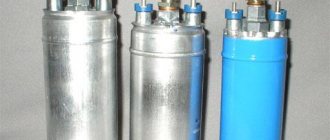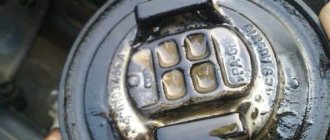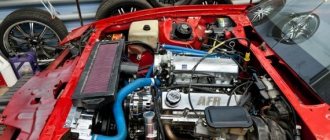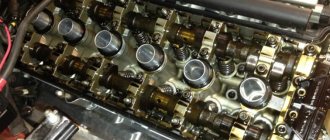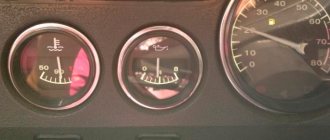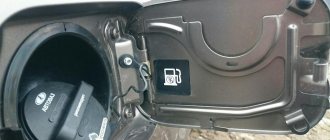When the starter spins when starting the engine, but the car does not start, many motorists begin to look for a problem in the battery. But sometimes it’s not his fault. In winter or autumn, when the air is damp or cold, starting the car in the morning can become a real problem. It turns out that quite often the spark plugs flood when starting the engine. Let's figure out why this happens. And how you can fight these.
How to check an injector nozzle for serviceability
Problems with injectors occur both on cars powered by diesel fuel and on gasoline-injected cars. An injector is a part responsible for injecting fuel under a certain pressure. It is useful to know how to check the injector nozzle if starting difficulties occur.
Causes and symptoms
Accurate metering of fuel, tightness of hoses and seals, activation of the injector at the right moment are prerequisites for stable and trouble-free operation of the engine. If the injection part leaks, as they say, then the efficiency of fuel atomization deteriorates, i.e., the shape of the flame is upset and the power unit smokes, either black or gray, it is difficult to start, consumption increases, and power is lost.
“The injector is leaking” is an expression that means fuel is leaking at a time when it is not needed.
There are many culprits for poor performance. For example, a dirty filter, a non-working fuel pump or bad spark plugs. The same thing happens due to the fault of a failed reel or due to problems with the timing belt.
The most important symptom of a non-working injector is difficulty starting the internal combustion engine. This is especially true for a “cold” engine. In addition, as mentioned above, symptoms include increased fuel consumption and unstable engine operation in idle mode. The last symptom generally resembles almost a tripping of the engine, as if one of the cylinders is not working.
As for the driving signs of a non-working injector.
- The car moves jerkily, especially when trying to accelerate. The accelerator pedal is dull.
- Jerking while driving, after changing gears or releasing the gas pedal.
- There is an undisguised fiasco in traction and aphasia of dynamics during acceleration or maneuver.
Defects in injection elements should be corrected immediately, otherwise it will negatively affect the service life of the engine and gearbox. Experts also do not recommend driving with a faulty injector, because it is simply dangerous. On steep climbs, when maneuvering and overtaking, a car with a failed injector can play a cruel joke on the driver.
How is diagnostics carried out?
You should know that car injectors are classified into several types. Today, two of them are in use: conventional and electric injection elements (magnetic).
Electric or, more correctly, electromagnetic injectors (EMF) are equipped with a special valve that supplies fuel. It, the valve, is controlled by the power unit ECU using sent pulses.
As for mechanical injectors, they open as the gasoline pressure in the injector increases, i.e., automatically.
On modern cars, the first variants of injectors are often installed - EMF.
Checking the injector itself without removing it
Injector testing can be done in several ways. However, in use
the simplest of them, and this is not surprising. It makes it possible to quickly test the injectors without even removing them from the car. The fundamental factor in such diagnostics is the analysis of the noise emitted by the motor during operation.
If a muffled high-frequency noise is heard from under the hood, this indicates the importance of cleaning the injectors or a problem with one of them.
Checking power supply
It is recommended to check how the power is going. This test option is carried out only when the injectors themselves are functioning flawlessly, but difficulties are observed with starting.
Here's how this kind of diagnosis is carried out:
- the block is disconnected from the injection system;
- two wires are connected to the battery, which are simultaneously connected at the other ends to the injectors;
- Now you need to start the engine and check the presence or absence of gasoline leakage.
According to the result, the following conclusions are drawn:
- if fuel leaks, it means there is a problem in the car’s electrical circuit;
- if not, then everything is fine.
Another test option involves using an ohmmeter. This method allows you to measure the resistance on the injectors, and draw conclusions accordingly.
This is done as follows.
- You need to find out the standard parameter of the injection elements of a particular car (for example, for a VAZ - 11-15 Ohms). Some foreign cars are of greater or lesser importance.
- Next, you need to disconnect the terminal from the battery, thereby de-energizing the system.
- Remove the electrical connector from the injector using a screwdriver with a thin pin. It will be enough to snap off the special clamp installed on the block.
- After this, connect the terminals of the device to the injection parts to measure the indicator.
In this way, you can measure the compliance of the resistance indicator with the required one. If deviations from the norms are noticeable, the faulty injector is removed from the vehicle and replaced with a known good one. After this, you can check the resistance again, and be sure to evaluate the operation of the motor. If everything was done correctly, the engine characteristics should change.
Analysis of the operation of injectors on the ramp
This method already involves dismantling the fuel rail. The injectors, of course, are removed along with the ramp. Then reconnect all electrical contacts to the ramp (after all, they are thrown off during dismantling). The negative terminal of the battery, which was removed earlier, also returns to its place.
- the ramp is placed in the engine compartment so that it is possible to place a container with a printed scale under the injectors;
- the fuel supply hoses are connected to the ramp (be sure to securely fix them at the ends);
- the engine is started by the starter (it is advisable to work together with an assistant);
- while the assistant rotates the starter, you need to test the operating efficiency of all injectors (gasoline must be supplied equally to all injectors);
- at the last stage of the procedure, the ignition is turned off, the level of gasoline in the containers is checked (obviously, the level should be the same).
Anyone can check the injector nozzle with their own hands. It is not necessary to go straight to a car service center if you encounter another problem. An experienced motorist should be able to do some repairs himself.
If you find an error, please select a piece of text and press Ctrl+Enter.
Source
Diesel engine noises indicating a malfunction
Every fan knows the sound of his car's engine. As a rule, it is quiet and measured, without any admixture of extraneous noise. However, the appearance of extraneous sounds, and especially knocking, gives many vehicle owners cause for concern. The reasons for knocking can be very diverse. Some indicate the need for scheduled maintenance, others indicate serious malfunctions and the need for urgent repairs of the diesel engine.
Among all kinds of engine problems, knocking noise when running a diesel engine is the most common occurrence. It is important to distinguish engine noise from the sound of the chassis. It is impossible to determine in absentia the cause of the knocking without conducting engine diagnostics, since many elements of the system can produce similar noises. Knocking can occur either from an insufficiently tightened part or from a failed motor element. In any case, you should not postpone your visit to the car service center.
Possible causes of fuel overflow
Too high a proportion of fuel in the oil leads to a thinning of the oil film, which, in turn, significantly impairs its performance and, accordingly, increases the degree of wear of engine components. This problem may have the following reasons:
- The injection system is incorrectly configured.
- The mixture enrichment system supplies too rich a mixture during a cold start.
- The injection nozzles do not work properly, for example, due to a clogged fuel filter.
- Due to the gap being too small, the piston hits the cylinder head, thereby causing uncontrolled injection of the injectors.
- Compression pressure is too low. This phenomenon may have the following reasons: The valve is leaking.
- The cylinder head gasket is leaking.
- The valve timing is not set correctly.
- The gap between the piston crown at top dead center and the cylinder head is too large
- One piston ring or several piston rings are defective.
- An error has occurred in the ignition system, for example, there is a faulty spark plug.
The injector is overflowing, what should I watch?
I had a problem, the car became very difficult to start when cold, i.e. it catches on - the speed increases to 1300-1500 and then stalls. Then start up like an old Lada - the fourth or fifth time. It’s easier when it’s hot, but the carburetor effect has appeared - the more you warm it up, the better it goes, and the engine wakes up after 2200 rpm. One day, after the first “setting”, I unscrewed the spark plugs; they were all filled with gasoline, and in the combustion chamber, in the light, puddles of gasoline were also visible. There is no doubt that the injectors are overfilling, all four at once. I’ll immediately make a reservation that the spark plugs, the fuel pump, its mesh, the mass air flow sensor, lambdas and injectors (since all four do not die at once) are in excellent health, the check does not light up or blink (at the diagnosis they told me so, there are no errors - there is nothing to scan). Another point - I drive on gas and there are no problems (with the engine, traction and consumption). But with the onset of cold weather, I have to start on gasoline - it will get worse, winter is not just around the corner. There are suspicions about the throttle position sensor because... he is also responsible for the number of injections, but H.H. normal and stable. CAN ANYONE TELL ME WHAT COULD BE?
Lada 2108 Autostudio NCS › Logbook › NOZZLES ARE POURING INTO THE CYLINDERS.
Hello subscribers and random visitors)))
Here I present to you my small problem. The car was not used for a long time, moved from place to place and, if absolutely necessary, no more than 60 km))))
I have long noticed poor engine starting after the car has been idle for a long time. When starting, the engine began to work first at 2x, then at 3x, and only after some time and at 4x after re-gassing and re-gassing)))) I periodically changed the spark plugs to start the engine.
I didn’t bother at that moment))) I was driving a Lada 2112 Car Wife - Auto Wife).
But then spring came and my beloved wife began to ask me: how soon will it move to 2112))))
And from that moment I decided to work on 2108 and began to resolve the issue of starting the engine.
It is obvious that there is a RICH air-fuel mixture. Previously, I had an entry about spark plugs in the BZ: SPARK PLUGS - DETERMINING THE MALFUNCTION.
I carried out diagnostics on the car, the mass air flow sensor is in a state of very bad condition - it needs to be changed.
HAVE BUT!
The spark plugs are very wet before the engine starts. I decided to conduct an experiment.
The conclusion suggests itself - THE INJECTORS ARE NOT CORRECTIVE
I dismantled the fuel rail, reconnected it to the fuel path, pumped up the pressure, turning the ignition on and off: I LOOK AT THE
INJECTORS - THE INJECTORS ARE WET, one more than the other less ((((
I drove it, the car doesn’t stall, it responds well to the gas pedal. I calmed down and put the car in boxing and went to bed)))) as always, stayed until NIGHT)))
Thank you for your attention)))) Feel free to comment)))))
We fix the problem ourselves
To fix the problem yourself, you need to at least know where the spark plugs are. There are several solutions. The first is installing a new kit, of course, if you have one. It is advisable not to throw away the old ones, but simply put them in the garage. In order to remove the spark plugs, you will need a special spark plug wrench, which almost every motorist has. However, the method is not suitable for everyone, due to the lack of a new kit.
Now let’s look at a method that involves using old candles. The fact is that they are not spoiled, but simply filled with gasoline, but drying alone is also not enough. Therefore, we will need a furnace in which we can heat the candle to a high temperature and change color to red. This event is carried out in order to get rid of residual fuel and the carbon deposits that have actually formed. But here you need to remember that in this case, firstly, the ceramics of the candle will deteriorate, and secondly, polishing will be required before installation.
Studying plaque on candles
They say that when candles are “flooded,” black soot forms. Let us clarify: it should not consist of inclusions. All metal, in turn, will be covered with an oily coating. Dry carbon looks different...
Oily layer and dry soot
The photo shows two cases. “Our version” is on the right.
And soot can also be brown. And it always, in 100% of cases, is formed due to flooding with gasoline.
An oily coating, as in photo 1, is, nevertheless, the result of oil ingress. But an oiled candle does not work correctly - it will also be “flooded”.
With regular “flooding,” carbon deposits form, which we see in photo 1 on the right and in photo 2. The rest does not apply to our case.
Main reasons
First, let's look at the main reasons for this phenomenon. Surprisingly, the main source of problems in this case is the car’s ECU and the features of its firmware.
When it’s below zero outside, the system tries to create certain conditions for the fuel mixture. It is no secret that in frosty air the volume of oxygen is much higher.
So it turns out that the ECU sends an order to the injectors to supply a larger volume of fuel.
Naturally, “orders are not discussed” and the injectors increase the amount of gasoline injected.
The injector is pouring into the cylinder: causes and solutions to the problem
Issues discussed in the material:
The fuel system of the car has changed significantly since its invention. A modern car can consume less fuel by smoothly adjusting the speed thanks to the dosed supply of the mixture. The engine injectors that make up the injection system are responsible for this function. This technology replaced the classic carburetor design, surpassing the latter in all respects. However, the injector is also susceptible to breakdowns. In particular, sometimes a situation arises when the injector pours into the engine cylinder. Why does this happen and how to deal with it? This will be discussed in this article.
How to prevent candles from flooding
As noted above, on new cars the question does not arise: what to do if the spark plugs are flooded, since this does not happen. But you can get rid of this on any car, you just need to comply with a number of important requirements. Firstly, you need to use special motor oil that does not thicken at low temperatures, this allows you to start the engine without much effort and stress on the battery and starter.
Secondly, high-quality fuel will not allow your spark plug to burn out. What to do if good gasoline is difficult to find? That's another question. At the very least, you shouldn’t look for gas stations with minimal prices, as you simply risk running into diluted fuel. The injection nozzles should always be adjusted and cleaned, this will have a positive effect on the starting time.
What to do if the candles are flooded, or Another solution
This method is used by almost all motorists, due to the high efficiency and simplicity of the method. To do this, we will not need to leave the car, because we will carry out the so-called blowing of the spark plugs. We completely squeeze out the accelerometer (gas) part, while turning the starter, at this time a large amount of air will flow to the cylinders and spark plugs, which is drying. During all this, the throttle valve must be fully open.
It should be noted that this method is applicable to both injection and carburetor engines. The only thing you need to be wary of is that your battery will not withstand such loads - it will die before the spark plugs dry. Again, due to the fact that the throttle valve is open to the maximum, gasoline does not flow to the combustion chambers, which is what we need. Now you know what to do if the spark plugs are flooded, but you need to consider the sequence of actions on fuel-injected cars as a separate item.
We diagnose the breakdown
The penetration of gasoline into the lubricant can be judged by the following factors:
- Motor fluid has become less viscous.
- The lubricant from the dipstick flashes. Oil, without foreign impurities, practically does not burn; if fuel is mixed with it, then checking this is quite simple. Place the dipstick with a certain amount of engine fluid near the flame of the lighter. If there is gasoline in the lubricant, there will be a bright flash on the dipstick.
- Increased fuel consumption.
- Reducing the power of the power unit.
- The appearance of extraneous noise in the motor.
- A drop of oil taken from the dipstick, when applied to a napkin or paper, forms a zone of transparent material around itself, which quickly evaporates.
If one of these signs is present, do not panic, try to find and eliminate the cause yourself.
Let's sum it up
The reasons for gasoline getting into the engine lubricant of a car equipped with an injector are as follows:
- Ignition system malfunction
- Worn injector nozzles.
- Malfunction of the fuel pump.
- Occurrence, coking of oil scraper rings.
- Piston system malfunction.
- Use of low-quality fuel.
The last reason is the most insidious. Gasoline is an aggressive chemical mixture with a certain amount of various additives, which should not come into contact with the engine oil of cars equipped with an injector: it can change the properties of the lubricant, destroy its structure - this will lead to drive failure. If you notice an admixture of gasoline in the engine fluid, eliminate the cause of this situation, then replace the engine mixture.
A large number of motorists, while operating a vehicle, periodically encounter difficulties starting the power unit. In this case, quite often there are no obvious prerequisites in the form of clearly manifested malfunctions. An unexpected engine failure to start can occur both during a cold start and when trying to start a previously warmed-up internal combustion engine. In such cases, one of the most common reasons why a car engine does not start is that the spark plugs in the engine are filled with gasoline or oil.
If the spark plugs on an injection engine or carburetor unit are flooded, starting the engine will be very difficult or completely impossible. This indicates the presence of certain problems both with the engine itself and with individual elements and systems. In this article we will talk about why spark plugs flood, how to understand why the spark plugs are flooded, and also what a driver should do if the car does not start, fill the spark plugs with gasoline or motor oil, etc.
What to do in this case?
Press the accelerator pedal all the way and turn the key in the ignition.
Crank the starter for 8-10 seconds. At the end of this time, the pedal can be returned to its original position.
In most cases, the engine starts.
The peculiarity of this method is that when the gas is fully pressed, the fuel supply to the engine is shut off, and the spark plugs themselves are blown exclusively with air.
If the engine still does not start, then you need to dry the spark plugs.
Communities › VAZ: Repair and Improvement › Blog › Pour more power
car 2114.2010. Euro 3 ECU M73 Avtel stock firmware. In general, symptoms. At idle there are small detonations, uneven operation. At rpm the car runs smoothly. fuel consumption per hour at idle at engine temperature 90 is 1-1.1, air consumption sometimes fluctuates 12 sometimes 13-14 threw an error outside the range of the knock sensor (replaced) misfires in cold weather the car does not want to start at all although the starter turns quickly and fills the spark plugs
And so I changed the whole assembly, coil + wires + spark plugs, idle sensor, canister valve, washed injectors (became better), adjusted the valves, timing marks are clearly changed, changed the mass air flow sensor. Compression is excellent, mileage 26t km (not exactly motorized), I think the cylinder head gasket is intact, there are no emulsions, the antifreeze does not leak Everything is okay
My assumptions are that the injectors are leaking, the question is how to check without a stand? So to speak, at home, a familiar diagnostician shrugs. There is no money for a stand and other diagnosticians, so I’ll have to do it myself
And another question along the way: the car does not go more than 160 in 4th, but if you put it in 5th, the speed drops?
How to do it?
The tools you can use are a regular toothbrush (or a metal brush) and a hair dryer (for more effective drying).
If you have the opportunity to take the candles home, you can “calcinate” them in the oven or directly on the burners. But this method is only temporary.
If the candles have already expired, then it is better to simply change them.
It happens that almost every day the spark plugs on the injector are filled. In such a situation, it is necessary to carry out a full check of the elements - for the presence of spark output, cleanliness of the injectors, quality of the spark, and so on.
Interesting read: Iridium spark plugs, pros and cons.
There is a spark, the starter turns normally, but the spark plugs are flooded
Quite often you can encounter a situation where there is a spark, the spark plugs are flooded, and the starter spins the crankshaft well. In such a case, the spark plugs may require a separate check, since the presence of a spark on them does not mean that the same spark will always be created under pressure. In other words, if there was a spark on the unscrewed spark plug, then after installation on the engine it may disappear. The reason is increased pressure in the combustion chamber, which is created during the operation of the internal combustion engine. To find out, you need to carry out diagnostics on a special stand for checking spark plugs, which simulates the operation of these elements taking into account high pressure (similar to the operation of spark plugs in the combustion chamber).
At the same time, the injectors themselves and ECM sensors may need diagnostics. For example, in the event of a malfunction, the coolant temperature sensor may send incorrect data to the computer. In this case, the control unit enriches the mixture and the injectors overflow fuel. In rare cases, the electronic engine control unit itself fails.
Source
Let's sum it up
In conclusion, I would like to say that the car must be prepared for use in the cold season. To do this, you need to switch the filter from summer mode to winter mode. It is also recommended to fully charge the battery, which will make starting easier. As for the candles themselves, it is advisable to always have a spare set with you, because it is unknown where they can be filled and what to do then.
The same applies to motor oil: it must be selected according to the manufacturer’s recommendations. And do not use mineral oils instead of synthetics. I would also like to note that if the cold start of the engine was unsuccessful the first time, then it is advisable to wait 20-25 seconds before starting the second. It must be remembered that over-enrichment of the mixture of air and gasoline can happen at any time, even when everything is working properly. But after reading this article, you already know what to do if the spark plugs are flooded, so you will always be prepared for such a problem to arise and eliminate it.
In cars equipped with an injector, fuel is injected under pressure using special nozzles. If gasoline gets into the engine oil, you need to look for a breakdown.

